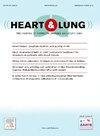Identification of patient-reported core information needs and associated factors in hospitalized patients with heart failure: A network analysis
IF 2.4
4区 医学
Q2 CARDIAC & CARDIOVASCULAR SYSTEMS
引用次数: 0
Abstract
Background
The lack of identified core information needs in patients with heart failure significantly hinders the development and implementation of personalized educational interventions.
Objectives
The purpose of this study was to identify the core information needs and explore the factors associated with information needs in patients with heart failure.
Methods
A total of 307 inpatients with heart failure were recruited from three cardiovascular units of a general hospital between February and December 2023. Self-reported questionnaires were used to assess patients’ sociodemographic and clinical characteristics, information needs, self-efficacy, social support, and health literacy. Network analysis and multiple linear regression were employed to analyze the data.
Results
The mean total score for information needs was 2.91 ± 0.50, with 42.3 % of patients with heart failure exhibiting a high level of information needs. Network analysis showed that the top four information needs were “exercise/physical activity” (strength = 1.09), “nutrition” (strength = 0.88), “emergency/safety” (strength = 0.83), and “diagnosis and treatment” (strength = 0.81). Self-efficacy, health literacy, age, and participation in cardiac rehabilitation lectures were associated with information needs.
Conclusions
A considerable proportion of patients with heart failure exhibit high levels of information needs. The top four information needs are “exercise/physical activity”, “nutrition”, “emergency/safety”, and “diagnosis and treatment”. Self-efficacy, health literacy, age, and participation in cardiac rehabilitation lectures are related to information needs. Therefore, healthcare providers should give priority to core information needs in patients with heart failure. Developing educational strategies based on patients’ individualized characteristics may be conducive to addressing their information needs.
心衰住院患者报告的核心信息需求及相关因素的识别:网络分析
心衰患者缺乏明确的核心信息需求,严重阻碍了个性化教育干预措施的发展和实施。目的了解心衰患者的核心信息需求,探讨影响心衰患者信息需求的因素。方法于2023年2月至12月在某综合医院3个心血管科室招募住院心力衰竭患者307例。采用自我报告问卷来评估患者的社会人口学和临床特征、信息需求、自我效能、社会支持和健康素养。采用网络分析和多元线性回归对数据进行分析。结果心衰患者信息需求总分平均为2.91±0.50分,42.3%的心衰患者信息需求水平较高。网络分析显示,排在前4位的信息需求分别是“运动/体育活动”(强度= 1.09)、“营养”(强度= 0.88)、“应急/安全”(强度= 0.83)和“诊疗”(强度= 0.81)。自我效能、健康素养、年龄和参加心脏康复讲座与信息需求相关。结论相当比例的心力衰竭患者存在较高的信息需求。排名前四位的信息需求是“运动/身体活动”、“营养”、“紧急/安全”和“诊断和治疗”。自我效能、健康素养、年龄和心脏康复讲座的参与与信息需求有关。因此,医疗保健提供者应优先考虑心衰患者的核心信息需求。根据患者的个性化特点制定教育策略可能有助于解决他们的信息需求。
本文章由计算机程序翻译,如有差异,请以英文原文为准。
求助全文
约1分钟内获得全文
求助全文
来源期刊

Heart & Lung
医学-呼吸系统
CiteScore
4.60
自引率
3.60%
发文量
184
审稿时长
35 days
期刊介绍:
Heart & Lung: The Journal of Cardiopulmonary and Acute Care, the official publication of The American Association of Heart Failure Nurses, presents original, peer-reviewed articles on techniques, advances, investigations, and observations related to the care of patients with acute and critical illness and patients with chronic cardiac or pulmonary disorders.
The Journal''s acute care articles focus on the care of hospitalized patients, including those in the critical and acute care settings. Because most patients who are hospitalized in acute and critical care settings have chronic conditions, we are also interested in the chronically critically ill, the care of patients with chronic cardiopulmonary disorders, their rehabilitation, and disease prevention. The Journal''s heart failure articles focus on all aspects of the care of patients with this condition. Manuscripts that are relevant to populations across the human lifespan are welcome.
 求助内容:
求助内容: 应助结果提醒方式:
应助结果提醒方式:


